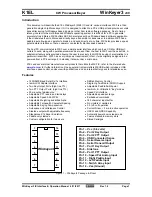
TC1796
Peripheral Units (Vol. 2 of 2)
Analog-to-Digital Converter (ADC)
User’s Manual
25-53
V2.0, 2007-07
ADC, V2.0
Additionally to this synchronized-request, the channel number (SYSTAT.CHNRSY), the
resolution (SYSTAT.RES), the external multiplexer information (SYSTAT.EMUX), the
analog input multiplexer group select state (SYSTAT.GRPS), and the cancel-sync-
repeat information (SYSTAT.CSREN) are transferred to the slave.
After the information is transferred to the slave, the master ADC module waits for the
acknowledgement of the slave. This indicates that both ADC modules are ready to start
their synchronized conversion. At reception of this acknowledge, the synchronized
conversion is started and bit STAT.REQSY is set. Bit STAT.REQSY indicates that a
synchronized conversion is currently performed and this ADC module provides master
functionality. After the currently performed synchronized conversion is completely
finished, bit STAT.REQSY is cleared and bit STAT.IENREQ is set.
Bits STAT.IENREQ and STAT.IENPAR are used for service request generation in the
master ADC module. In order to generate a service request after both ADC modules
have finished their synchronized conversion, the master checks bit STAT.IENPAR,
which is driven by the slave. In case both ADC modules have finished their conversion,
bit STAT.IENREQ and STAT.IENPAR are set. This generates a service request (bit
MSS1.MSRSY is set). As well as setting bit MSS1.MSRSY, both bits STAT.IENREQ and
STAT.IENPAR are automatically cleared.
Slave Functionality
On reception of the synchronized request (bit SYSTAT.SYREQ is set), the channel
number (SYSTAT.CHNRSY), the resolution (SYSTAT.RES), the external multiplexer
information (SYSTAT.EMUX), the analog input multiplexer group select state
(SYSTAT.GRPS), as well as the cancel-sync-repeat information (SYSTAT.CSREN) are
driven by the master. Beside this synchronized request derived from the master,
the
evaluation of an arbitration result of the slave is disabled
. Thus, the slave itself
cannot generate a request.
Then, the cancel-sync-repeat enable bit is evaluated. This bit specifies whether a
conversion that is currently performed in the slave is cancelled (SYSTAT.CSREN = 1) or
not (SYSTAT.CSREN = 0). Note that a synchronized conversion cannot be cancelled by
another synchronized conversion. Bit STAT.REQSY is set to indicate that this module is
the partner (slave) in a synchronized conversion.
The handshake guarantees that the master and the slave are ready to start a
synchronized conversion if the synchronized request is still active (bit SYSTAT.SYREQ
is set in the slave). In the case that bit SYSTAT.SYREQ is cleared in the meantime by
the master, the ADC module continues with normal behavior.
Beside the start of conversion, the synchronized request (bit SYSTAT.SYREQ) is
cleared, bit STAT.PARSY is set, and the write to the arbitration result is enabled anew.
At the end of the synchronized conversion, the master’s status bit STAT.IENPAR is
controlled by the slave and the slave’s status bit STAT.PARSY is cleared.
















































